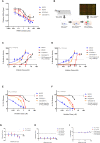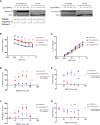Type I PRMT Inhibition Protects Against C9ORF72 Arginine-Rich Dipeptide Repeat Toxicity
- PMID: 33013410
- PMCID: PMC7508178
- DOI: 10.3389/fphar.2020.569661
Type I PRMT Inhibition Protects Against C9ORF72 Arginine-Rich Dipeptide Repeat Toxicity
Abstract
Repeat expansion mutations in the C9ORF72 gene are the most common genetic cause of amyotrophic lateral sclerosis (ALS) and frontotemporal dementia (FTD). Repeat-associated non-AUG translation of this expansion produces dipeptide repeat proteins (DRPs). The arginine containing DRPs, polyGR and polyPR, are consistently reported to be the most toxic. Here we demonstrated that small molecule inhibition of type I protein arginine methyltransferases (PRMT) protects against polyGR and polyPR toxicity. Furthermore, our findings suggest that asymmetric dimethylation of polyGR and polyPR by Type I PRMTs plays important roles in their cytotoxicity.
Keywords: ALS (Amyotrophic lateral sclerosis); C9ORF72 DPRs; FTD (Fronto-Temporal Dementia); arginine methylation; glycine-arginine; proline-arginine; protein arginine methyl transferase.
Copyright © 2020 Premasiri, Gill and Vieira.
Figures


Similar articles
-
Hypothesis and Theory: Roles of Arginine Methylation in C9orf72-Mediated ALS and FTD.Front Cell Neurosci. 2021 Mar 23;15:633668. doi: 10.3389/fncel.2021.633668. eCollection 2021. Front Cell Neurosci. 2021. PMID: 33833668 Free PMC article.
-
Reduced C9orf72 expression exacerbates polyGR toxicity in patient iPSC-derived motor neurons and a Type I protein arginine methyltransferase inhibitor reduces that toxicity.Front Cell Neurosci. 2023 Apr 17;17:1134090. doi: 10.3389/fncel.2023.1134090. eCollection 2023. Front Cell Neurosci. 2023. PMID: 37138766 Free PMC article.
-
C9orf72 arginine-rich dipeptide proteins interact with ribosomal proteins in vivo to induce a toxic translational arrest that is rescued by eIF1A.Acta Neuropathol. 2019 Mar;137(3):487-500. doi: 10.1007/s00401-018-1946-4. Epub 2019 Jan 2. Acta Neuropathol. 2019. PMID: 30604225 Free PMC article.
-
Arginine-rich dipeptide-repeat proteins as phase disruptors in C9-ALS/FTD.Emerg Top Life Sci. 2020 Dec 11;4(3):293-305. doi: 10.1042/ETLS20190167. Emerg Top Life Sci. 2020. PMID: 32639008 Free PMC article. Review.
-
Emerging Perspectives on Dipeptide Repeat Proteins in C9ORF72 ALS/FTD.Front Cell Neurosci. 2021 Feb 18;15:637548. doi: 10.3389/fncel.2021.637548. eCollection 2021. Front Cell Neurosci. 2021. PMID: 33679328 Free PMC article. Review.
Cited by
-
Hypothesis and Theory: Roles of Arginine Methylation in C9orf72-Mediated ALS and FTD.Front Cell Neurosci. 2021 Mar 23;15:633668. doi: 10.3389/fncel.2021.633668. eCollection 2021. Front Cell Neurosci. 2021. PMID: 33833668 Free PMC article.
-
Reduced C9orf72 expression exacerbates polyGR toxicity in patient iPSC-derived motor neurons and a Type I protein arginine methyltransferase inhibitor reduces that toxicity.Front Cell Neurosci. 2023 Apr 17;17:1134090. doi: 10.3389/fncel.2023.1134090. eCollection 2023. Front Cell Neurosci. 2023. PMID: 37138766 Free PMC article.
-
Targeting Gene C9orf72 Pathogenesis for Amyotrophic Lateral Sclerosis.Int J Mol Sci. 2025 Apr 30;26(9):4276. doi: 10.3390/ijms26094276. Int J Mol Sci. 2025. PMID: 40362512 Free PMC article. Review.
-
C9-ALS-Associated Proline-Arginine Dipeptide Repeat Protein Induces Activation of NLRP3 Inflammasome of HMC3 Microglia Cells by Binding of Complement Component 1 Q Subcomponent-Binding Protein (C1QBP), and Syringin Prevents This Effect.Cells. 2022 Oct 5;11(19):3128. doi: 10.3390/cells11193128. Cells. 2022. PMID: 36231090 Free PMC article.
-
Protein Arginine Methyltransferases in Neuromuscular Function and Diseases.Cells. 2022 Jan 21;11(3):364. doi: 10.3390/cells11030364. Cells. 2022. PMID: 35159176 Free PMC article. Review.
References
LinkOut - more resources
Full Text Sources
Other Literature Sources
Miscellaneous

